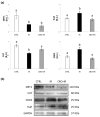Crocetin Mitigates Irradiation Injury in an In Vitro Model of the Pubertal Testis: Focus on Biological Effects and Molecular Mechanisms
- PMID: 33802807
- PMCID: PMC8002482
- DOI: 10.3390/molecules26061676
Crocetin Mitigates Irradiation Injury in an In Vitro Model of the Pubertal Testis: Focus on Biological Effects and Molecular Mechanisms
Abstract
Infertility is a potential side effect of radiotherapy and significantly affects the quality of life for adolescent cancer survivors. Very few studies have addressed in pubertal models the mechanistic events that could be targeted to provide protection from gonadotoxicity and data on potential radioprotective treatments in this peculiar period of life are elusive. In this study, we utilized an in vitro model of the mouse pubertal testis to investigate the efficacy of crocetin to counteract ionizing radiation (IR)-induced injury and potential underlying mechanisms. Present experiments provide evidence that exposure of testis fragments from pubertal mice to 2 Gy X-rays induced extensive structural and cellular damage associated with overexpression of PARP1, PCNA, SOD2 and HuR and decreased levels of SIRT1 and catalase. A twenty-four hr exposure to 50 μM crocetin pre- and post-IR significantly reduced testis injury and modulated the response to DNA damage and oxidative stress. Nevertheless, crocetin treatment did not counteract the radiation-induced changes in the expression of SIRT1, p62 and LC3II. These results increase the knowledge of mechanisms underlying radiation damage in pubertal testis and establish the use of crocetin as a fertoprotective agent against IR deleterious effects in pubertal period.
Keywords: HuR; SIRT1; X-rays; autophagy; crocetin; fertility preservation; oxidative stress; pubertal testis; radiotherapy; saffron.
Conflict of interest statement
The authors declare no conflict of interest.
Figures




Similar articles
-
Ferulic acid protects against radiation-induced testicular damage in male rats: impact on SIRT1 and PARP1.Environ Sci Pollut Res Int. 2018 Mar;25(7):6218-6227. doi: 10.1007/s11356-017-0873-6. Epub 2017 Dec 14. Environ Sci Pollut Res Int. 2018. PMID: 29243149
-
Protective Effects of Crocetin against Radiation-Induced Injury in Intestinal Epithelial Cells.Biomed Res Int. 2020 Sep 8;2020:2906053. doi: 10.1155/2020/2906053. eCollection 2020. Biomed Res Int. 2020. PMID: 32964024 Free PMC article.
-
Crocetin protects ultraviolet A-induced oxidative stress and cell death in skin in vitro and in vivo.Eur J Pharmacol. 2016 Oct 15;789:244-253. doi: 10.1016/j.ejphar.2016.07.036. Epub 2016 Jul 21. Eur J Pharmacol. 2016. PMID: 27452919
-
Exploring the therapeutic efficacy of crocetin in oncology: an evidence-based review.Naunyn Schmiedebergs Arch Pharmacol. 2024 Mar;397(3):1455-1476. doi: 10.1007/s00210-023-02714-z. Epub 2023 Sep 22. Naunyn Schmiedebergs Arch Pharmacol. 2024. PMID: 37736836 Review.
-
Protective Effect of Sirt1 against Radiation-Induced Damage.Radiat Res. 2021 Dec 1;196(6):647-657. doi: 10.1667/RADE-20-00139.1. Radiat Res. 2021. PMID: 34459925 Review.
Cited by
-
Crocus sativus L. Extract and Its Constituents: Chemistry, Pharmacology and Therapeutic Potential.Molecules. 2021 Jul 12;26(14):4226. doi: 10.3390/molecules26144226. Molecules. 2021. PMID: 34299500 Free PMC article.
-
Nuclear and Radiological Emergencies: Biological Effects, Countermeasures and Biodosimetry.Antioxidants (Basel). 2022 May 31;11(6):1098. doi: 10.3390/antiox11061098. Antioxidants (Basel). 2022. PMID: 35739995 Free PMC article. Review.
-
The potential protective role of carotenoids from saffron: A focus on endoplasmic reticulum stress-related organ damage.Food Sci Nutr. 2024 Jun 21;12(9):6108-6122. doi: 10.1002/fsn3.4289. eCollection 2024 Sep. Food Sci Nutr. 2024. PMID: 39554322 Free PMC article. Review.
References
MeSH terms
Substances
LinkOut - more resources
Full Text Sources
Other Literature Sources
Medical
Miscellaneous

